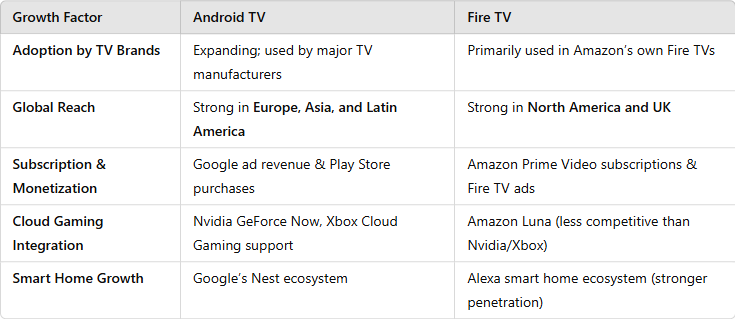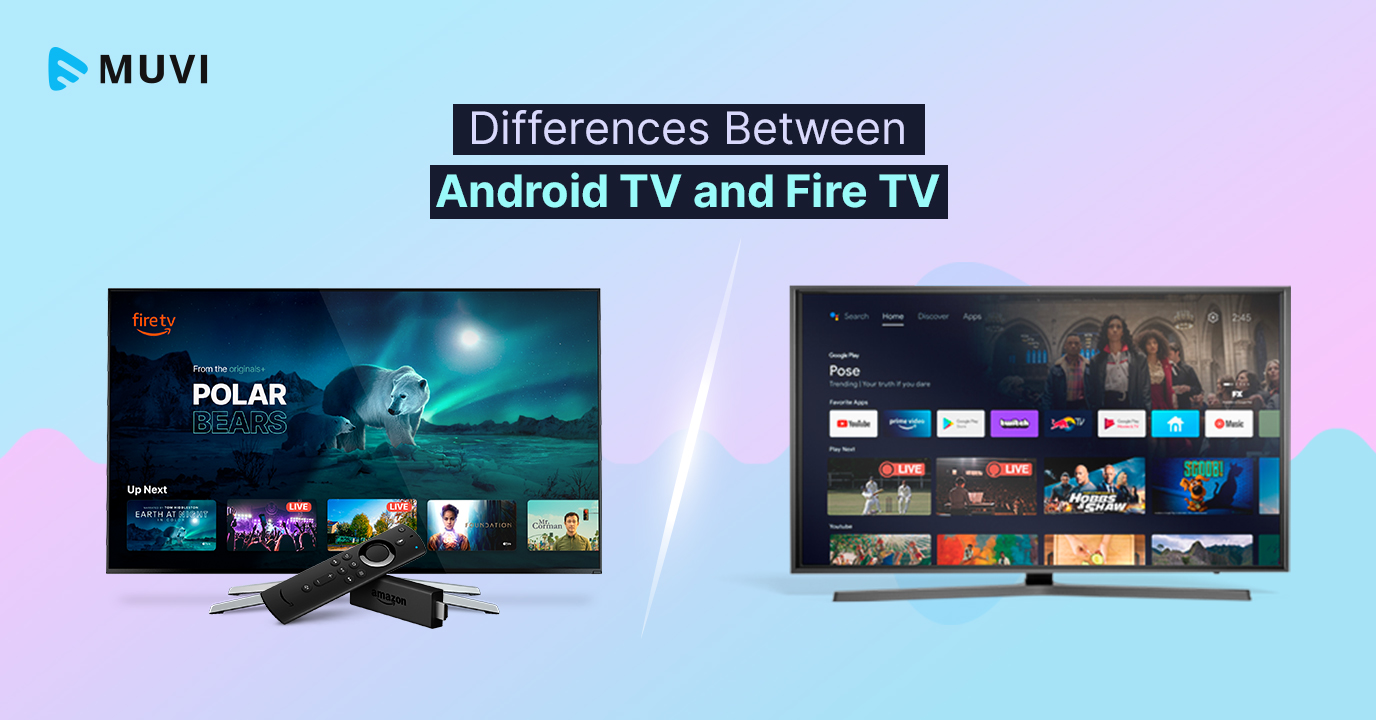Android TV and Fire TV are both in high demand around the globe due to their several advantages, such as being easy to use, great compatibility, access to a wide pool of apps, advanced voice search, and other features.
As revealed by Google, the Android TV OS, including Android TV and Google TV, has over 270 million active devices as of 2024. The spike in usage and ownership for Fire TV has also surpassed the 200 million mark.
For most streaming players, Android TV and Fire TV have become integral to targeting potential ecosystems or scaling up their businesses.
If you, too, are from the streaming sector or are simply wondering about the differences between Android TV and Fire TV, then this blog is for you.
Here, we are going to do a comparative analysis of Android TV vs Fire TV and talk about various factors that you should consider before developing your Android TV app or Fire TV app. So, let’s get started!
Android TV Overview
An Android TV refers to a TV with an Android operating system. Precisely, Android TV is an Android-based smart TV OS (Operating System) developed by Google in June, 2014.
Android TV OS applies to diverse devices such as digital media players, soundbars, set-top boxes, and television sets. Android TV is related to Google TV, as they both share the same operating system, Android TV OS.
There have been several releases since 2014, such as Android TV 10, released in December 2019, Android TV 11 in September 2020, and Android TV 12 in November 2021.
Launch Your TV Streaming App Seamlessly With Muvi Now! Sign up for a Free Trial!
Are Android TV and Google TV the same?
No, Android TV and Google TV are different from each other in terms of features and services. Though both are owned by Google and share the same OS – Android TV OS- both smart TV devices are completely different.
Google TV is an updated version of Android TV, and it offers better UX, greater compatibility in navigation, and more features and functionalities for users. Android TV has its own pros like wide adoption across digital devices and cheaper pricing as compared to Google TV.
In this blog, we will exclusively talk about Android TV vs Fire TV, and will also highlight about Google TV vs Fire TV.
Also Read: Google TV Vs Android TV: A Comparative Guide
Fire TV Overview
Released in April 2014, Amazon Fire TV refers to a set of microconsoles and digital media players that are developed by Amazon. It is a media streaming device that can transform your TV viewing experience by turning your TV into a smart one.
The Fire TV device family comprises several device types such as Fire TV Cube, Fire TV soundbar, Fire TV streaming media player, smart TVs with Fire TV built, and Echo Show. The second generation of Amazon Fire TV was released in 2015, while in 2016, Amazon introduced the Fire TV edition with built-in Amazon Fire OS and Fire TV interface.
In 2018, Amazon introduced Fire TV Recast, an over-the-air television digital video recorder that is used for viewing purposes with Amazon Fire TV and Amazon Echo Show devices. However, it was discontinued in August 2022.
Now, let’s talk about the main differences between Android TV and Fire TV.
Key Differences Between Android TV and Fire TV
Android TV and Fire TV differ from each other in several ways, as mentioned below.
Android TV Vs Fire TV: Software & Apps
Two of the major differentiating factors between Android TV and Fire TV are their software & apps.
Android TV, equipped with more than 700 million shows and movies from diverse apps like Netflix, Amazon Prime Video, Disney+, and others, can be your choice if you are more inclined to Google Play Store app content.
Also, you can watch Apple TV+ content on Android TV. Not only does it come with Google Assistant that executes voice commands easily, but lets you easily cast videos, images, music and others from your preferred devices to your TV through its built-in Chromecast.
Amazon Fire TV, on the other hand, runs on the Fire OS that is based on Amazon’s Android Open Source Project and has mainly three versions – Fire OS 7, which is based on Android 9, Fire OS 6 based on Android 7.1, and Fire OS 5 based on Android 5.1.
Fire TV offers a range of apps, such as Peacock TV, Pluto TV, Paramount+, and HBO Max, to name a few. It comes with Alexa and also, Amazon Fire TV Stick functions similar to Chromecast – you can simply plug it into the HDMI (High-Definition Multimedia Interface) port of your TV to turn it into a smart TV.
From a developer perspective, you can easily Build Amazon Fire TV App and publish your apps for your audience.

Android TV Vs Fire TV: Ecosystem, Market & Growth Scope
Android TV and Fire TV both come with their respective ecosystems, their pros and cons.
As stated in a recent market report, the global Android TV market is set to reach US $272 million by 2032 while growing at a CAGR of 13.90% through 2025 – 2032.
With the spiking demand in the commercial, industrial, and residential sectors, the Android TV ecosystem is taking the spotlight for the streaming market players to utilize the upcoming growth scope this market offers. Furthermore, as it supports both Android and Apple TV+ and Apple TV content, it lets you target both ecosystems.
According to a recent report, the Fire OS has 6.4% market share, while nearly 200 million Fire TV devices were sold yearly as stated in 2024.
While the app range is not that extensive like Android TV, Fire TV lets you access apps from the Amazon app store along with the major apps like Hulu, HBO Max, Disney+, Netflix, and others.
As revealed in a recent study, the Amazon app store revenue is 89% of the Apple app store revenue, while Google Play revenue is 23% of the Apple app store revenue. Also, there are over 779 million apps in the Amazon app store, which definitely depicts lucrative growth scope for the streaming players targeting the Fire TV ecosystem.
Also read: What are the differences between WebOS and Android TV?
Android TV Vs Fire TV: User Interface
The user interface plays an important role in determining the user experience, engagement, and ease of access. Android TV and Fire TV both stand out from each other in terms of UI (User Interface).
Android TV comes with a neat and easy-to-navigate user interface that includes a simple menu with Search, Home, Discover, and Apps. The apps, shows, and movies are displayed in the form of streamlined rows with the advertised and favorite content at the top.
You can easily discover content of your preferences from the Discover tab as well as get personalized recommendations for various apps, shows, and movies. Also, you can easily customize the Android TV home screen through a few button clicks.
Fire TV also comes with a simple and catchy user interface that includes three main menu items – Home, Find, and Live. You can browse through the lists of apps, shows, and movies as well as the lists of recently watched movies, shows, and sponsored content. Also, you can easily search your preferred content or choose from the recommendations.
However, comparing Fire TV vs Android TV in terms of flexibility and customization, Android TV’s UI is better than Fire TV.

Android TV Vs Fire TV: Voice Control
Fire TV’s Alexa gives a tough competition to Android TV’s Google Assistant while both of them come with their own pros and cons. Be it launching an app, controlling the volume, or searching for a new show or series, both Android TV and Fire TV’s voice control feature helps you execute them with ease.
Google Assistant is better in terms of AI-powered operations, while Alexa also comes with its competitive voice assistant feature.
Through voice control, you can execute multiple tasks starting from knowing weather reports to playing music and more. Also, both these virtual assistants let you transform your home into a smart home where you can easily control your lights, appliances, thermostats, and other WiFi connected devices while watching your favorite shows.
Android TV Vs Fire TV: The Bottom Line

Android TV vs Fire TV is one of the most discussed topics among the viewers as well as the streaming market players.
If you are targeting a Smart TV OS that offers an open ecosystem and has a global reach, then Android TV OS should be your choice. However, if you’re specifically looking to target Amazon/Alexa users, then opt for Fire TV OS.
While many consider the Android TV ecosystem and growth opportunities to be superior to Fire TV, both have their own advantages and unique perks. As a streaming market player, you can opt for any or even both of them to expand your reach, scale your business, and increase your profitability.
Muvi One, an all-in-one OTT solution, lets you easily launch your own branded Android as well as Fire TV app, even without writing a single line of code. Furthermore, Muvi One supports multiple smart TV environments in including Android TV, Fire TV, Roku, Apple TV, and LG TV, to name a few. Take a 14-day free trial today to explore more (no credit card required).

Recommended Reads:
What is Fire TV? How Fire TV Works? – Everything You Need to Know
What are the Differences Between Roku and Fire TV?
Google TV Vs Android TV: A Comparative Guide
How To Create Android TV App in 5 Simple Steps [WITHOUT CODING]
How to Develop a Fire TV App Without Coding?

















Add your comment